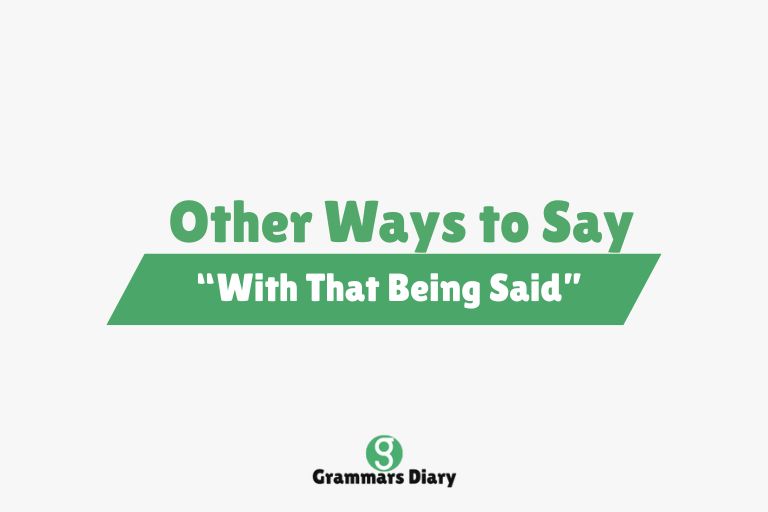The phrase “with that being said” is commonly used to signal a transition in thought, often introducing a contrast, a clarification, or a shift in direction during a discussion or written explanation. It’s one of those bridge phrases that helps maintain flow and coherence while subtly alerting the listener or reader that something different, perhaps even slightly contradictory, is about to follow.
However, just like many transitional phrases in English, overusing “with that being said” can make your writing feel repetitive or formulaic. That’s why it’s helpful to explore a broader vocabulary of alternatives that serve a similar function, each offering its own tone or nuance depending on the situation. In this article, we’ll explore 18 powerful substitutes for “with that being said” and explain when and how to use them effectively.
Other Ways to Say “With That Being Said”
1. That Being the Case
Example: “The event is scheduled for next week. That being the case, we need to finalize our preparations today.”
Meaning: This phrase logically connects the previous statement to a consequence or necessary action.
Usage: Best suited for formal writing or professional discussions, especially when drawing conclusions.
2. Even So
Example: “The data was incomplete. Even so, the team proceeded with the analysis.”
Meaning: It introduces a contrast by acknowledging a limitation but proceeding despite it.
Usage: Ideal for persuasive or explanatory writing where you want to highlight resilience or reasoning.
3. Nevertheless
Example: “The path was steep and difficult. Nevertheless, she reached the summit.”
Meaning: A formal word indicating that a conclusion or action is taken in spite of the previous fact.
Usage: Works well in professional, academic, and literary contexts to express determined action or thought.
4. All the Same
Example: “He apologized for the delay. All the same, the client was not satisfied.”
Meaning: Suggests that despite some acknowledgment or justification, the outcome remains unchanged.
Usage: Often used in conversational or semi-formal writing to express a continued opinion or stance.
5. Still
Example: “It’s a risky investment. Still, the potential returns are attractive.”
Meaning: Adds contrast or emphasis while keeping the tone brief and direct.
Usage: Common in speech and informal writing when a quick shift in reasoning is needed.
6. Even Though That’s True
Example: “The weather forecast calls for rain. Even though that’s true, we’ll go ahead with the picnic.”
Meaning: Acknowledges the truth of a statement while expressing willingness to proceed regardless.
Usage: Conversational in tone and best for informal contexts where nuance matters.
7. Having Said That
Example: “The product performs well in most conditions. Having said that, it struggles in extreme heat.”
Meaning: Softens a contradictory or limiting point that follows a positive statement.
Usage: A frequently used spoken transition, especially effective in presentations or interviews.
8. At the Same Time
Example: “I value tradition. At the same time, I believe innovation is essential.”
Meaning: Expresses dual perspectives without dismissing either side.
Usage: Suitable for thoughtful, balanced writing or speech where two ideas need to coexist.
9. Be That as It May
Example: “She has little experience. Be that as it may, her enthusiasm is unmatched.”
Meaning: Acknowledges a potential drawback but maintains a differing opinion or decision.
Usage: Formal and slightly old-fashioned, but still effective in literary or structured writing.
10. Regardless
Example: “We’ve had some delays. Regardless, the launch will proceed on Friday.”
Meaning: Signals that the upcoming action or decision is unaffected by the previous circumstance.
Usage: Often used in both professional and informal settings to show determination or continuity.
11. In Any Case
Example: “We may not have all the answers yet. In any case, we must act quickly.”
Meaning: Suggests moving forward despite uncertainties or doubts.
Usage: Casual yet clear; suitable for general writing or speech when wrapping up a point.
12. In Light of That
Example: “The budget has been cut. In light of that, we’ll need to adjust our plans.”
Meaning: A logical bridge from a cause to its consequence.
Usage: Frequently used in formal writing and reports to signal logical adjustments or reasoning.
13. With This in Mind
Example: “We know the risks involved. With this in mind, we’ve decided to proceed cautiously.”
Meaning: Connects previous understanding with upcoming actions or considerations.
Usage: Works well in academic, business, or explanatory writing.
14. Then Again
Example: “It might be a waste of time. Then again, we won’t know unless we try.”
Meaning: Introduces doubt or a second perspective that contrasts with the first.
Usage: Informal in tone and often used in everyday speech or casual writing.
15. On the Other Hand
Example: “Online learning offers flexibility. On the other hand, it may lack social interaction.”
Meaning: Provides a contrast or alternative viewpoint.
Usage: Very common in structured arguments, comparisons, or balanced discussions.
16. Moving On
Example: “We’ve covered the budget. Moving on, let’s talk about staffing.”
Meaning: Indicates a clear transition from one topic or idea to the next.
Usage: Effective in presentations, meetings, or writing that covers multiple points.
17. In Turn
Example: “She helped the team finish early. In turn, they supported her initiative.”
Meaning: Highlights a cause-effect relationship or sequence of actions.
Usage: Works best in structured or analytical writing to demonstrate logical flow.
18. Now Then
Example: “We’ve addressed all the concerns. Now then, let’s begin the final review.”
Meaning: Signals a new direction or the resumption of focus.
Usage: Slightly old-fashioned, but effective for speeches or polite conversation.
When to Use Different Alternatives to “With That Being Said”
In Formal Writing or Public Speaking
In business reports, essays, public speeches, or academic publications, clarity and tone are paramount. Phrases like “nevertheless,” “in light of that,” or “with this in mind” help establish a polished and respectful tone while clearly guiding the audience through a shift in argument or direction.
In Casual or Conversational Contexts
When writing blogs, emails, or having daily conversations, simpler and more relaxed phrases like “still,” “even so,” or “then again” can offer natural-sounding transitions. These keep the tone light while still providing a smooth change in focus or thought.
In Academic or Analytical Writing
Precision and logical connection are essential in academic texts. In this case, options like “in turn,” “on the other hand,” and “be that as it may” provide effective bridges between thoughts, helping readers follow complex reasoning and nuanced arguments.
Conclusion
The phrase “with that being said” is an effective tool for transitioning between ideas, offering contrast, or clarifying a stance. However, relying on it too often can make your communication feel monotonous or predictable. By learning and incorporating a wider range of transitional phrases, you not only elevate your writing but also tailor your tone and intention more precisely to your audience and purpose.
Whether you’re writing a formal report, giving a speech, or just trying to improve your day-to-day conversations, these 18 alternatives provide a robust toolkit for smoother, more expressive transitions.
FAQs
What does “with that being said” mean?
It typically introduces a statement that contrasts or adds a new dimension to what was just mentioned. It’s used to signal a shift in thought or to gently lead into a differing point of view.
Is “with that being said” formal or informal?
It is moderately formal and works in both professional and casual conversations, but overuse can make writing repetitive or dull. That’s why learning synonyms or alternatives is useful.
Can I use “having said that” instead of “with that being said”?
Yes, “having said that” is nearly identical in meaning and can usually be used interchangeably, though it may sound slightly more conversational.
Which alternative is best for essays or reports?
Formal choices like “nevertheless,” “in light of that,” or “with this in mind” are more appropriate for essays, research papers, or business reports where tone and logic are critical.











